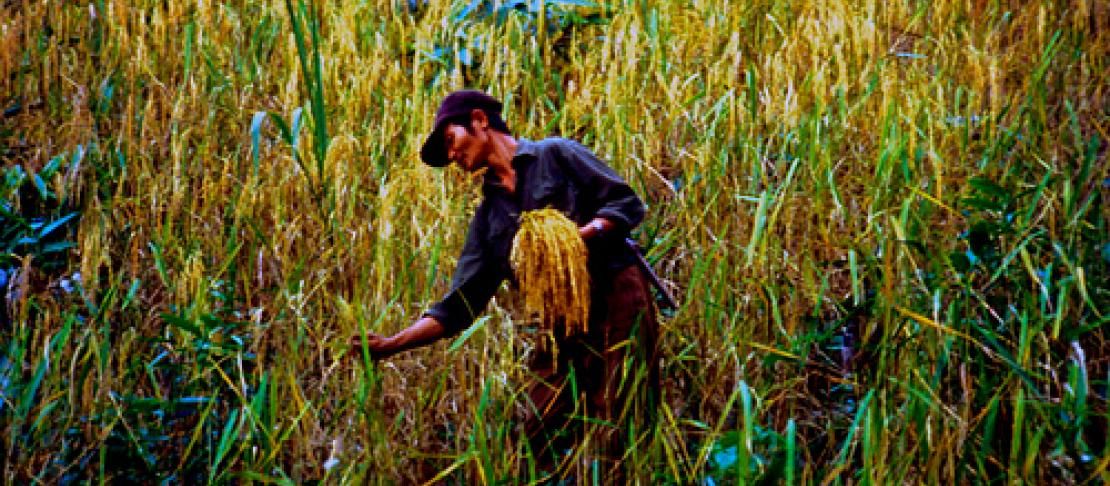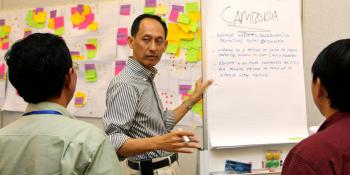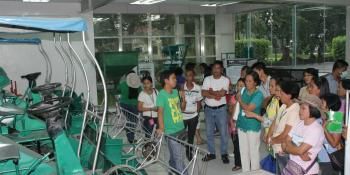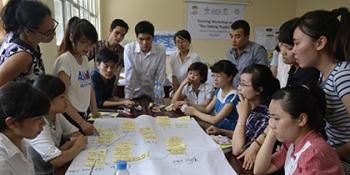Asia's rice bowls get a new ally in climate fight

by Vanessa Meadu
In Vietnam, everywhere you look there is food. Before dawn, people haul away huge bags of produce, meat, fish and flowers to later sell on the city streets. On every sidewalk of every town, people are chopping, washing, cooking food. And from morning to night, folks are eating at makeshift pavement restaurants, or grabbing refreshment from a steaming or sizzling mobile stall, perched on the backs of their motorbikes.
This country takes food and agriculture very seriously, and has made incredible progress in the last few decades, going from importing most of its food to becoming a major food exporter, and a leading global rice producer and exporter. In recent years neglected crops like cassava have become major income generators in Vietnam, contributing to poverty alleviation.
Much of this growth is due to government and international investment in Vietnam's small-scale farmers. But climate change is a hazard to this progress. At worst, it threatens millions of people who depend on agriculture, from farmers in the Mekong Delta to consumers in the Philippines and beyond who depend on cheap rice for nutrition.
Undeniable facts: grounds for expansion into Southeast Asia
There are compelling reasons why the CGIAR Research Program on Climate Change, Agriculture and Food Security (CCAFS) has chosen to expand into this region: large, growing populations; major reliance on agriculture for sustenance and economic growth; and high vulnerability of agriculture to sea level rise, floods, droughts, and extreme events. On top of that, agriculture in this region is a major contributor to greenhouse gas emissions, either directly (such as methane emissions from rice paddies) or indirectly (agriculture driving deforestation). CCAFS program director Bruce Campbell gave a broad overview of the case for working in Southeast Asia at an event yesterday to launch the Program.
With a bit of fanfare, the CCAFS officially opened its Southeast Asia office in Hanoi, Vietnam. The International Center for Tropical Agriculture (CIAT), which leads CCAFS globally, launched its own Hanoi office at the same time. Housed in Vietnam's Agricultural Genetics Institute (AGI) at the Vietnam Academy of Agricultural Sciences (VAAS), and led by the International Rice Research Institute (IRRI), the CCAFS SEA program is already standing on the shoulders of research giants in the region.
Much to learn from countries in this region
I asked Campbell what we could learn from Southeast Asia. “There are many excellent examples of climate-smart agriculture in Vietnam that could potentially be adapted for countries in Africa and other regions,” he told me.
Before the launch, CCAFS scientists were treated to a field visit which included a stop in Phu Tho, two hours away from Hanoi. This is where the Red River Delta meets Vietnam's northern mountainous regions, and we could spot hills emerging from the haze behind the rice paddies.
 We visited a small family farm that was abuzz: dozens of sows and piglets grunting in one paddock; a fish pond with resident ducks flapping on the water; bamboo beehives scattered around the property; about a hundred chickens; and a handful of workers tending to a rice field. At the back property, a small woodlot provided much-needed shade. All of these land uses were being managed together in a sustainable, intensive system known as 'VAC' or Vườn, Ao, Chuồng ('garden/pond/livestock pen'). In this farm, nutrients from the pond help fertilise rice and maize, while livestock manure generates biogas for cooking. The farm produces enough rice to feed a family of six and generates steady income through the rest of its products, allowing the family to save and invest in education, materials, and possible new ventures. We learned that there are hundreds of farms following a similar model in Phu Tho province, and many more scattered across the entire country. An integrated and intensive system such as VAC already gives farmers advantages in the race against climate change: they do not rely on one single crop for their income, but many; and greenhouse gas emissions are reduced thanks to nutrient cycling and intensification instead of expansion.
We visited a small family farm that was abuzz: dozens of sows and piglets grunting in one paddock; a fish pond with resident ducks flapping on the water; bamboo beehives scattered around the property; about a hundred chickens; and a handful of workers tending to a rice field. At the back property, a small woodlot provided much-needed shade. All of these land uses were being managed together in a sustainable, intensive system known as 'VAC' or Vườn, Ao, Chuồng ('garden/pond/livestock pen'). In this farm, nutrients from the pond help fertilise rice and maize, while livestock manure generates biogas for cooking. The farm produces enough rice to feed a family of six and generates steady income through the rest of its products, allowing the family to save and invest in education, materials, and possible new ventures. We learned that there are hundreds of farms following a similar model in Phu Tho province, and many more scattered across the entire country. An integrated and intensive system such as VAC already gives farmers advantages in the race against climate change: they do not rely on one single crop for their income, but many; and greenhouse gas emissions are reduced thanks to nutrient cycling and intensification instead of expansion.
In other parts of Asia, farmers are embracing mobile technologies. IRRI's NMRiceMobile application helps farmers and extension workers decide what kind of fertiliser to apply, how, and when. The app has taken off in the Philippines and there are plans to develop a similar one for Vietnamese farmers. Not only does the app provide useful guidance for day to day decision making, it also collects vital information from farmers about the size and scope of their activities. This gives researchers insights and data, including the ability to calculate greenhouse gas emissions from rice production.
These are just two examples of many. Campbell pointed to the need for cross-regional learning: “we need to use the best knowledge available to develop approaches that can be scaled up to reach hundreds and thousands of vulnerable farmers around the world."
Learning from successful initiatives outside the region
The foundations for strong, sustainable, smallholder agriculture have been laid by Southeast Asian governments and their agencies, CGIAR partners, universities, and farmers. CCAFS plans on building on this, bringing together tools, approaches and knowledge that the program's scientists and partners are testing in other parts of the world.
In East and West Africa, researchers and farmers are taking a journey to the future, to identify analogue sites that can generate lessons for adaptation. In India, CCAFS Southeast Asia is working with the private sector and farmers to develop insurance products that can reduce farmers' vulnerability to heat and drought-induced crop failures. Index-based agricultural insurance schemes may be an important tool for helping farmers innovate in tough times.
So when Vietnam's Agriculture leaders cut the ceremonial ribbon with leaders from CCAFS, IRRI and CIAT they ushered in a new era of cooperation, but more importantly, they opened the door to a more food-secure future in this region
#ccafsSEA officially open along with @ciat_Vietnam office. Deputy Minister of Ag cuts the ribbon cc:@riceresearch twitter.com/cgiarclimate/s…
— CGIAR Climate (@cgiarclimate) May 7, 2013
Read more:
Press release, 7 May 2013. Climate change research hub opens in Vietnam
View more pictures
Vanessa Meadu is Communications and Knowledge Manager for the CGIAR Research Program on Climate Change, Agriculture and Food Security (CCAFS). The CCAFS Southeast Asia Program is led by the International Rice Research Institute (IRRI). The CCAFS lead CGIAR center is the International Center for Tropical Agriculture (CIAT).


